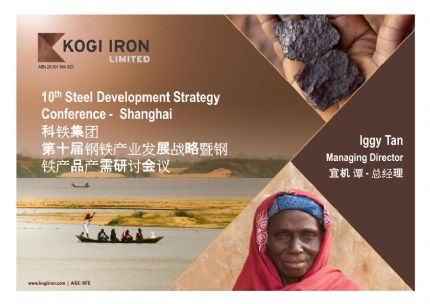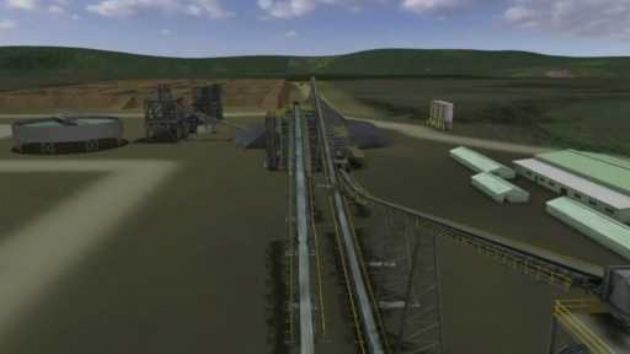 Reports Barging Study Completed
Reports Barging Study Completed
Perth, Oct 14, 2013 AEST (ABN Newswire) - Australian based iron ore development company, Kogi Iron Limited ( ASX:KFE) ("Kogi Iron" or the "Company") is pleased to report the results of a Niger River Barging Study for its 100% owned Agbaja Iron Ore Project ("Agbaja Project"). The study was conducted by South African port and coastal engineering consultants, Prestedge Retief Dresner Wijnberg (Pty) Ltd ("PRDW"). PRDW was appointed by Kogi's 100% owned Nigerian subsidiary KCM Mining Ltd to investigate the feasibility of using river barges to transport iron ore concentrate via the Niger River from Agbaja to the coast near the Warri Port, then transhipment to larger ocean-going vessels ("OGV") moored offshore. The study proposes a number of alternatives, each of which was assessed and compared to select the optimal solution for incorporation into the Scoping Study.
ASX:KFE) ("Kogi Iron" or the "Company") is pleased to report the results of a Niger River Barging Study for its 100% owned Agbaja Iron Ore Project ("Agbaja Project"). The study was conducted by South African port and coastal engineering consultants, Prestedge Retief Dresner Wijnberg (Pty) Ltd ("PRDW"). PRDW was appointed by Kogi's 100% owned Nigerian subsidiary KCM Mining Ltd to investigate the feasibility of using river barges to transport iron ore concentrate via the Niger River from Agbaja to the coast near the Warri Port, then transhipment to larger ocean-going vessels ("OGV") moored offshore. The study proposes a number of alternatives, each of which was assessed and compared to select the optimal solution for incorporation into the Scoping Study.
Concept 1 - Warri Stockpile
This option considered the use of a stockpile facility at Port Warri. It assumed the use of existing port infrastructure and the continuous delivery of iron ore concentrate by river barges from a barge loading facility at Banda on the Niger River, proximal to the Agbaja Project. A separate fleet of deeper draft sea-going barges makes use of the deeper river channels 50 nautical miles ("NM") from Warri via the Chanomi Creek to the Escravos River mouth, and a further 18 NM to the transhipment site to load the OGV.
Concept 2 - Forcados Stockpile
This option extended the river barging leg to reach a proposed stockpile site near the mouth of the Forcados River. This option offered the shortest overall distance, but the depth at the Forcados River bar is shallower than the depth at the Escravos River bar, which limits the sea-going barge parcel size. The establishment of the stockpile facility at this greenfield site would incur the additional capital cost of constructing new quay structures for berthing barges and site clearance for stockpile areas.
Concept 3 - Escravos Stockpile
This option located a stockpile at the mouth of the Escravos River with a river leg of 325 NM via the Forcados River and Chanomi Creek channel. The deep river entrance and the short sea leg help to reduce the OGV loading time even further. The Escravos stockpile would incur the capital cost of constructing new infrastructure.
Concept 4 - Direct Transhipment
This option considered the delivery of iron ore concentrate by river barge directly to the OGV vessel for transhipment. This option offered a saving in construction and operation of a stockpile facility but incurs costs of demurrage. Demurrage costs relate to the standby rates for OGVs.
Concept 5 - Direct Transhipment with Floating Storage Unit ("FSU")
This option considered the use of a FSU moored at the transhipment site for stockpiling and transhipment. The FSU is a retro-fitted Capesize vessel equipped to offload iron ore from river barges to storage in the hold and then tranship to OGVs, which moor alongside. This option is able to eliminate demurrage entirely, but incurs the additional cost of the long journey for the river barges and the laden river barges are required to operate offshore.
Study Parameters
The PRDW study also reported on the following areas:
1. Site selection process for the barge loading berth;
2. Stockpiles and the transhipment location;
3. Site information required for each location and each leg of the barging operation;
4. Information received from transhipment operators;
5. Simulation of barge logistics using a discrete event simulation software programme;
6. Marine infrastructure required for each berth and stockpile facility as well as details of the various transhipment systems;
7. Equipment requirements for each barging alternative;
8. Order of magnitude cost estimates for CAPEX and OPEX for each alternative barging operation;
9. Project implementation schedule for the construction of all the berths and the commissioning of barges, tugs and transhipment units required;
10. Results of the optimisation of the barging logistics simulation and the preferred option on the basis of cost; and
11. Recommendations of the study as well as a discussion of the options for future throughput expansion.
Conclusions and Recommendations
The use of the Warri Stockpile (Concept 1) is currently considered the optimal option from an operating and capital cost prospective. This option assumes the use of existing port infrastructure and allows for the continuous delivery of iron ore concentrate by river barges. A separate fleet of deeper draft sea-going barges will make use of the deeper river channels from Warri via the Chanomi Creek to the Escravos River mouth, and a further 18 NM to the transhipment site to load the OGV. The use of existing port infrastructure at Warri minimises capital costs compared to other options, which involve the construction of new berths.
A barge loading location, south of Banda was recommended due to proximity to the new Lokoja-Abuja A2 highway, the access road to the Niger River, seasonal variation in water levels and the least exposure to flooding. The Niger River is currently used for general river vessel traffic and is suited for barging of iron ore. The Federal Government of Nigeria is responsible for a capital dredging campaign and maintenance of navigation buoys. The potential location for a transhipment operation (at 5deg 23' N, 5deg 03' E) considers a maximum OGV design representing the 95% coverage rate for a Capesize vessel with a parcel size of 185,000t. The report recommends that a delivery lead time of 24 to 26 months should be considered in the schedule for the procurement of transhipment equipment.
Kogi Iron Managing Director Iggy Tan said: "The barging work by PRDW was of a very high standard and will form the basis of the Scoping Study underway to evaluate a 5 Mtpa iron ore operation at Agbaja. The PRDW work demonstrates that barging transportation of our iron ore product is not only a readily available and effective transport route, but identifies a most economical option."
"The barging study demonstrated a lower capital and operating cost scenario for the proposed 5 Mtpa operation, compared to using the existing un-utilised Itakpe/Ajaokuta railway line to Port Warri, which is more suited to larger annual tonnages.
However, the Company will continue to advance access and usage agreements with the Nigerian Government for the heavy haulage railway, as this remains an important part of a longer term transport solution for an expanded production profile beyond 5 Mtpa."
To view all pictures, please visit:
http://media.abnnewswire.net/media/en/docs/ASX-KFE-652384.pdf
About Macro Metals Limited
Macro Metals Limited is an ASX-listed company (ASX:M4M) with the intent to build a cast steel plant on the Agbaja Plateau in Kogi State, Nigeria. The project will utilise company leased iron ore deposits and will supply a cast steel feedstock to steel manufacturing and product fabricators in Nigeria and overseas.
![abnnewswire.com]()
Related Companies
Social Media
Share this Article

 ASX:KFE) ("Kogi Iron" or the "Company") is pleased to report the results of a Niger River Barging Study for its 100% owned Agbaja Iron Ore Project ("Agbaja Project"). The study was conducted by South African port and coastal engineering consultants, Prestedge Retief Dresner Wijnberg (Pty) Ltd ("PRDW"). PRDW was appointed by Kogi's 100% owned Nigerian subsidiary KCM Mining Ltd to investigate the feasibility of using river barges to transport iron ore concentrate via the Niger River from Agbaja to the coast near the Warri Port, then transhipment to larger ocean-going vessels ("OGV") moored offshore. The study proposes a number of alternatives, each of which was assessed and compared to select the optimal solution for incorporation into the Scoping Study.
ASX:KFE) ("Kogi Iron" or the "Company") is pleased to report the results of a Niger River Barging Study for its 100% owned Agbaja Iron Ore Project ("Agbaja Project"). The study was conducted by South African port and coastal engineering consultants, Prestedge Retief Dresner Wijnberg (Pty) Ltd ("PRDW"). PRDW was appointed by Kogi's 100% owned Nigerian subsidiary KCM Mining Ltd to investigate the feasibility of using river barges to transport iron ore concentrate via the Niger River from Agbaja to the coast near the Warri Port, then transhipment to larger ocean-going vessels ("OGV") moored offshore. The study proposes a number of alternatives, each of which was assessed and compared to select the optimal solution for incorporation into the Scoping Study.











